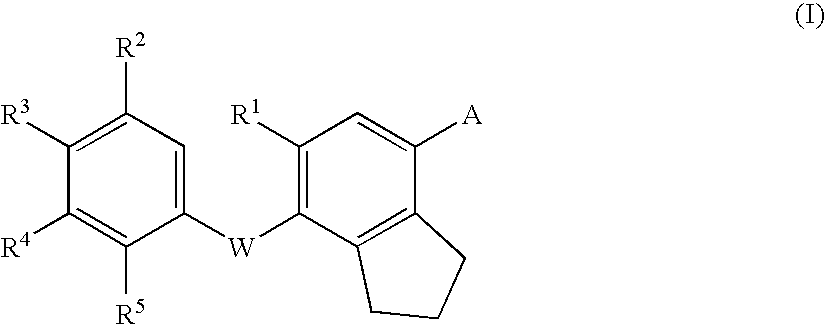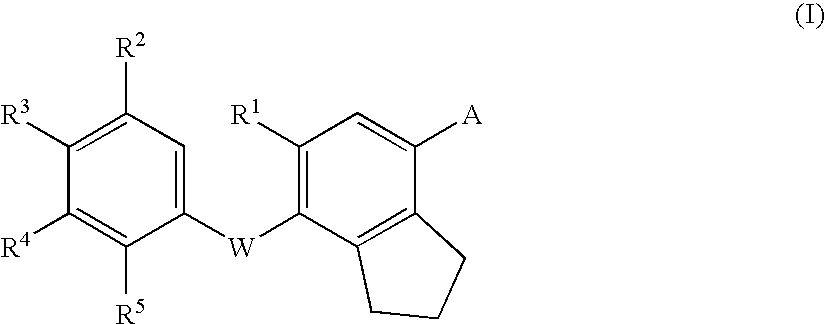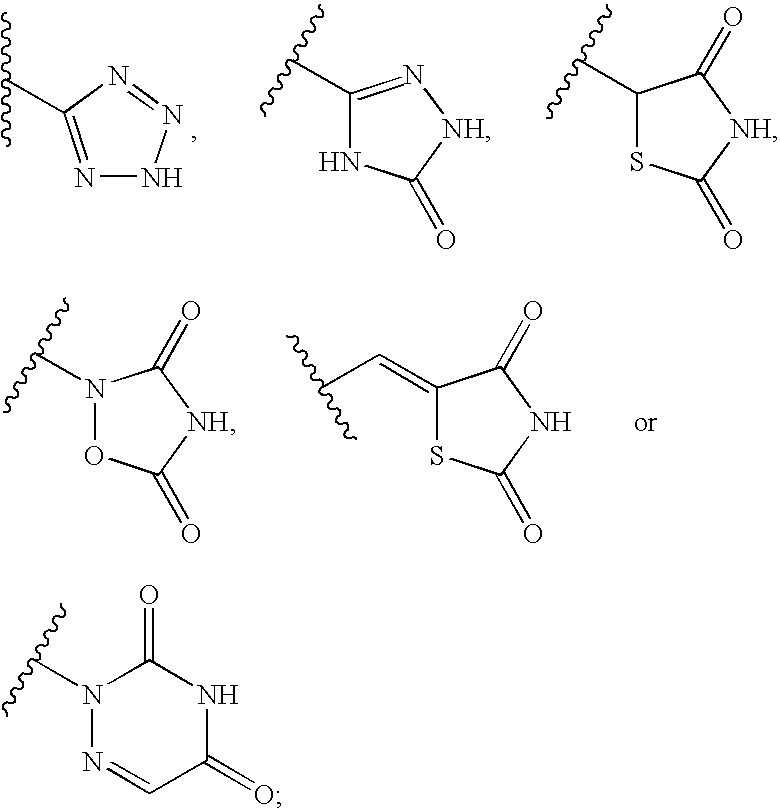Thyroid hormone receptor ligand, medicinal compositions containing the same and use thereof
a thyroid hormone and receptor technology, applied in the field of new drugs, can solve the problems of cardiac toxicities and dosages of thyroid hormones more than those of replacement therapy, and achieve the effects of reducing serum triglyceride, improving glucose tolerance in peripheral tissues, and easing obesity
- Summary
- Abstract
- Description
- Claims
- Application Information
AI Technical Summary
Benefits of technology
Problems solved by technology
Method used
Image
Examples
reference example 1
5-Bromoindan-4-ol
To a solution of indan-4-ol (24.2 g) in dichloromethane (200 mL) was added diisopropylamine (2.55 mL). To the solution was added N-bromosuccinimide (32.07 g) in small portions under ice-cooling, and the mixture was stirred at room temperature overnight. Diluted sulphuric acid (pH1, 200 mL) was added to the reaction mixture, and the mixture was separated. The organic layer was washed with water and brine successively, and dried over anhydrous magnesium sulfate. The solvent was removed under reduced pressure. The residue was purified by column chromatography on silica gel (eluent: hexane / ethyl acetate=3 / 1−1 / 1) to give the title compound (31.1 g).
1H-NMR (CDCl3) δ ppm: 2.05–2.16 (2H, m), 2.83–2.95 (4H, m), 5.45 (1H, s), 6.69 (1H, d, J=8.0 Hz), 7.22 (1H, d, J=8.0 Hz).
reference example 2
5-Iodo-7-nitroindan-4-ol
To a solution of 5-iodoindan-4-ol (358 mg) in acetic acid (3 mL) was added water (0.5 mL). To the solution was added nitric acid (60%, 0.105 mL) in small portions under ice-cooling, and the mixture was stirred under ice-cooling for 20 min. After adding water (10 mL) and aqueous sodium sulfite (1.5 g / 10 mL) successively, the mixture was extracted with ethyl acetate. The organic layer was washed with water, saturated sodium hydrogen carbonate and brine successively, and dried over anhydrous magnesium sulfate. The solvent was removed under reduced pressure. The residue was crystallized from a small amount of dichloromethane and hexane to give the title compound (70 mg).
1H-NMR (CDCl3) δ ppm: 2.13–2.22 (2H, m), 2.95–3.01 (2H, m), 3.35–3.44 (2H, m), 5.81 (1H, s), 8.40 (1H, s).
reference example 2-1
5-Bromo-7-nitroindan-4-ol
The title compound was prepared in a similar manner to those described in Reference Example 2 using 5-bromoindan-4-ol instead of 5-iodoindan-4-ol.
1H-NMR (CDCl3) δ ppm: 2.13–2.26 (2H, m), 2.95–3.02 (2H, m), 3.36–3.43 (2H, m), 6.04 (1H, s), 8.25 (1H, s).
PUM
| Property | Measurement | Unit |
|---|---|---|
| peripheral vascular resistance | aaaaa | aaaaa |
| body temperature | aaaaa | aaaaa |
| body weight | aaaaa | aaaaa |
Abstract
Description
Claims
Application Information
 Login to View More
Login to View More - R&D
- Intellectual Property
- Life Sciences
- Materials
- Tech Scout
- Unparalleled Data Quality
- Higher Quality Content
- 60% Fewer Hallucinations
Browse by: Latest US Patents, China's latest patents, Technical Efficacy Thesaurus, Application Domain, Technology Topic, Popular Technical Reports.
© 2025 PatSnap. All rights reserved.Legal|Privacy policy|Modern Slavery Act Transparency Statement|Sitemap|About US| Contact US: help@patsnap.com



